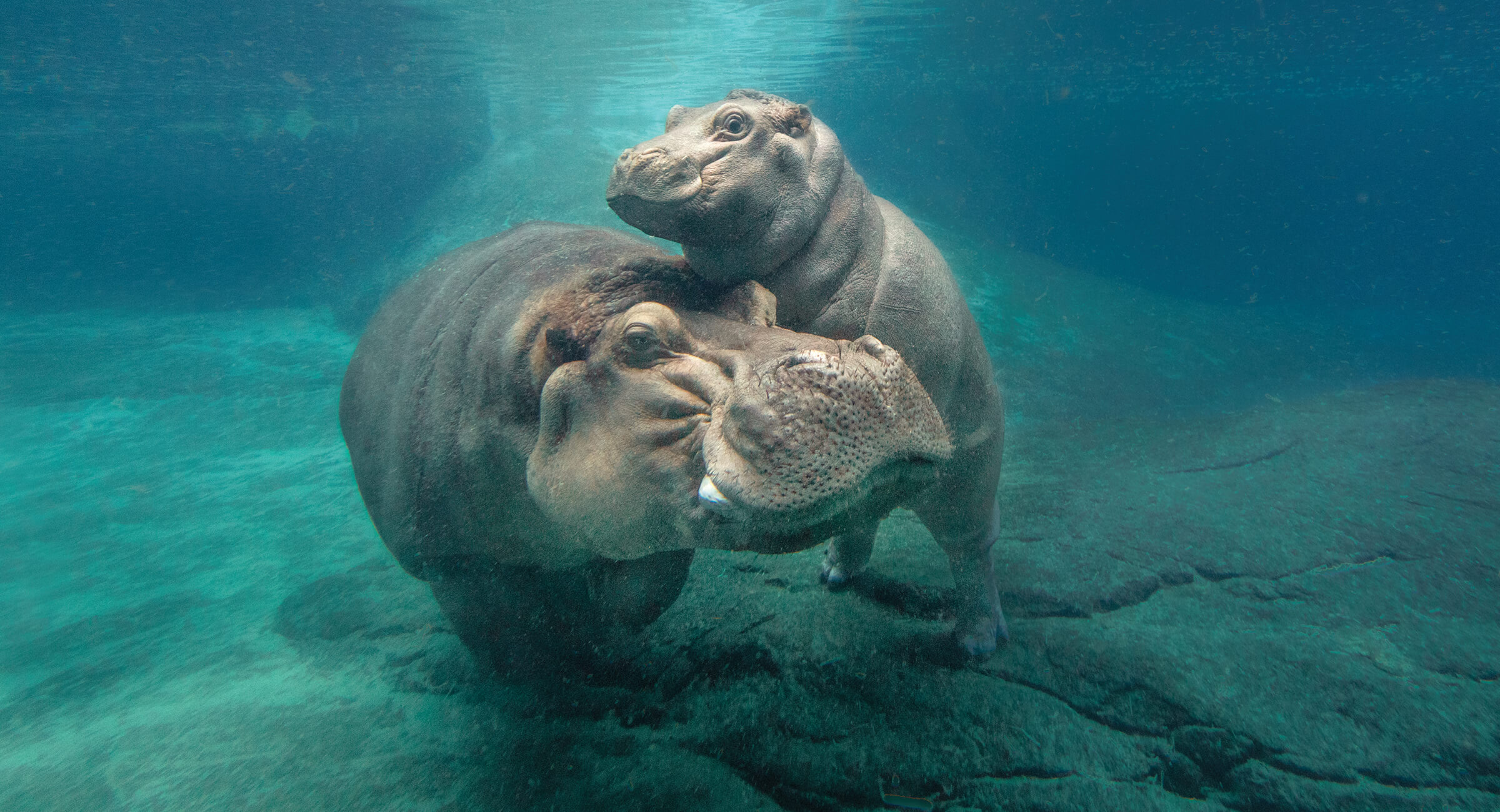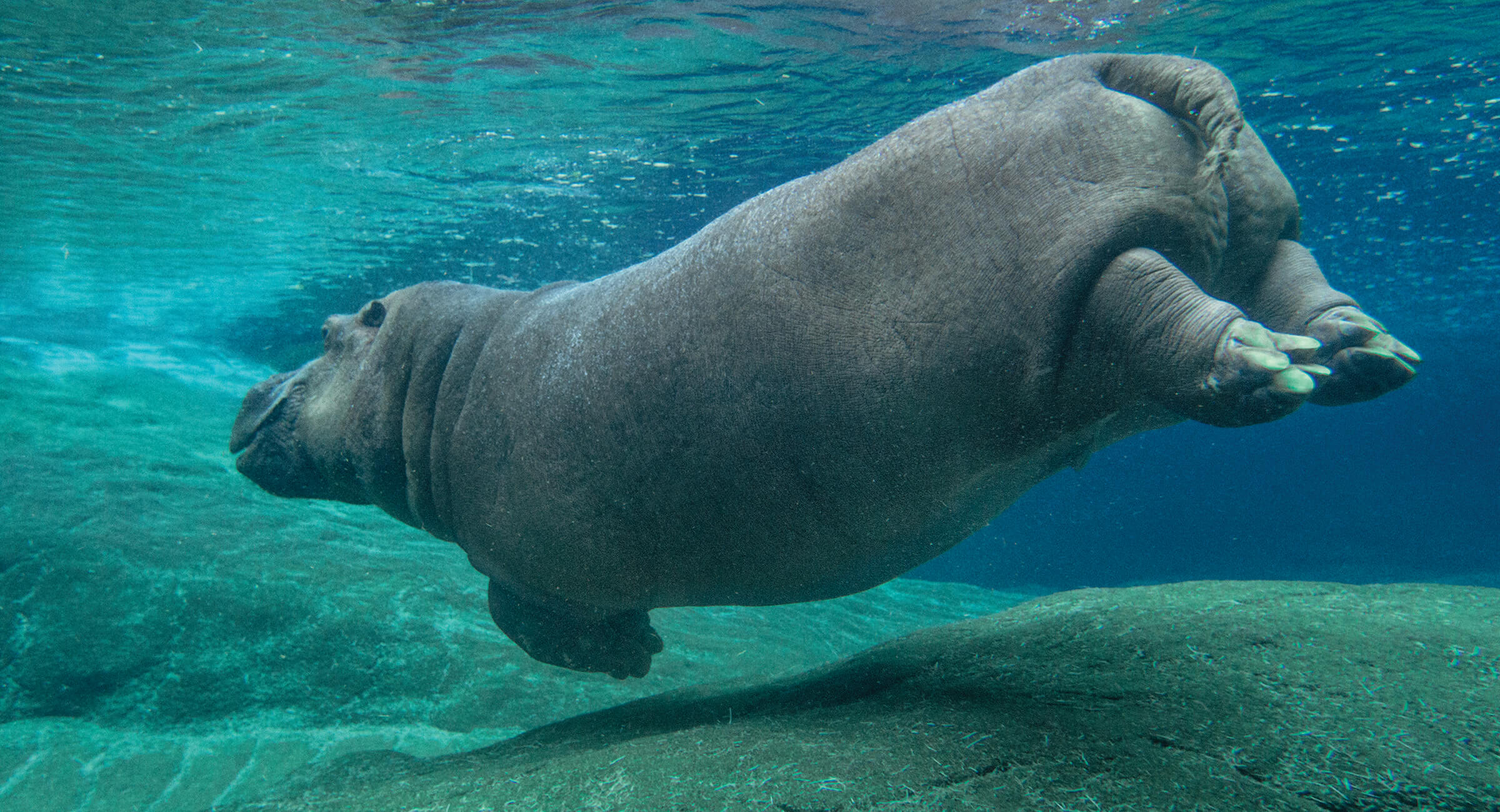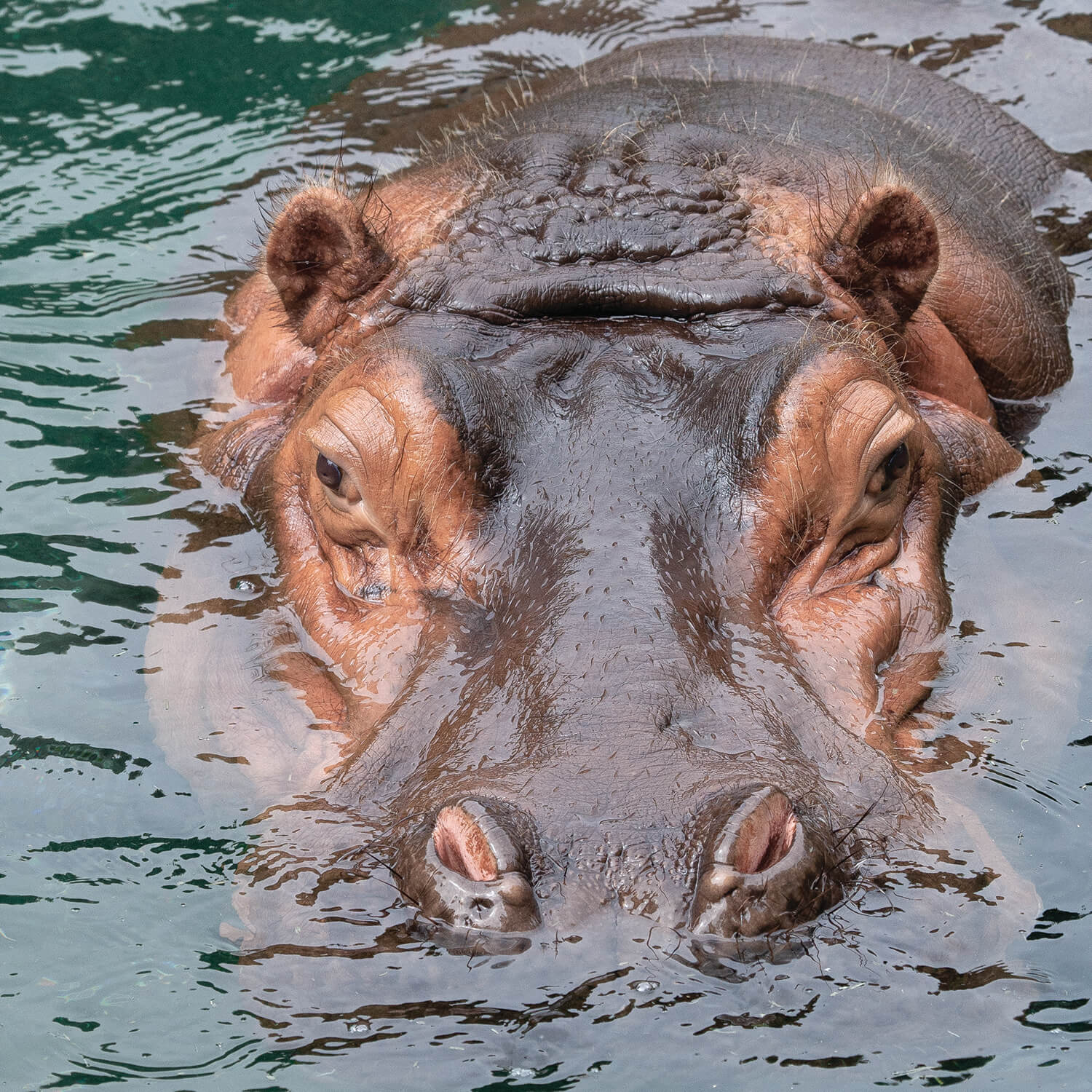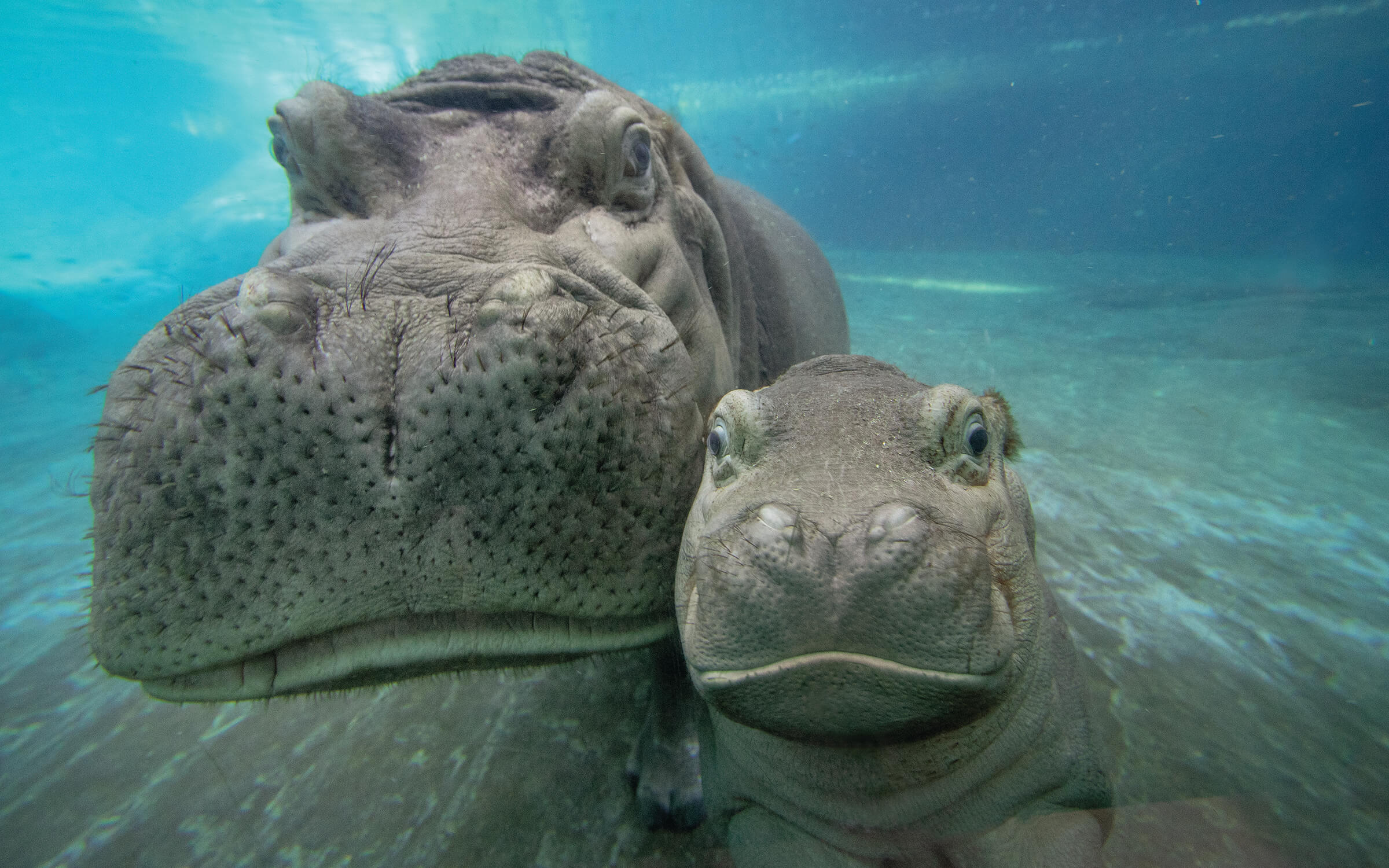BY Eston Ellis
Photography by Ken Bohn
Watching Tony, the Zoo’s young river hippopotamus, at play in the pool along Hippo Trail is always fascinating. He spends hours performing his version of underwater ballet, pushing off with his feet, gliding past his fans, and doing an occasional barrel roll. He’ll spar with his mother, Funani, then make graceful turns near the window before surfacing. He seems so at home underwater, you might think he was a marine mammal. There’s a good reason for that.
Scientists used to think hippos were closely related to pigs and other even-toed, hoofed ungulates, and classified them as members of the Order Artiodactyla—along with pigs, goats, sheep, and camels. However, as genetic researchers began to study the DNA of many animal species, they discovered that hippos are much more closely related to cetaceans—whales, porpoises, and dolphins. In fact, cetaceans are hippos’ closest living relatives.

RELATIVELY CLOSE
Genetic research indicates that hippos are closely related to whales, porpoises, and dolphins.
(Photo by Janos/iStock/Getty Images)
A Whale of a Discovery
According to scientists, a common ancestor of hippos and whales, the extinct pig-like Anthracotheres, split off from even-toed ungulates about 60 million years ago. These four-legged, semi-aquatic mammals were ruminants—grazing or browsing animals with multichambered stomachs. Then, about 54 million years ago, hippos and cetaceans diverged. In cetaceans, front feet became fins, and back legs mostly vanished in order to support horizontal tail flukes, as the animals became totally aquatic. Today, there are 89 cetacean species, ranging in size from the 3-foot-long Maui’s dolphin to the nearly 100-foot-long blue whale.
There are just two types of hippos, however: river hippos Hippopotamus amphibius, and the smaller, less aquatic pygmy hippos Choeropsis liberiensis. Both hippo species are nocturnal herbivores found in Africa that spend most of each day in water, then roam to nearby grasslands to graze at night. River hippos live in rivers and estuaries near grasslands. Pygmy hippos live in the forests of Liberia and along rivers in Côte d’Ivorie in West Africa.
All in the Family
Surprisingly, today’s whales and hippos still share many characteristics. The bones in the front feet of a hippo and those inside the fins of a whale are remarkably similar. Whales and hippos both have multichambered stomachs suited for grazing, although today’s whales don’t feed on vegetation.
Like hippos, whales have single, non-lobed lungs that fill and expel air quickly. Both species also have muscles to constrict airways in the bronchioles of their lungs. However, while some whales can stay underwater for up to two hours without surfacing to breathe, hippos can remain submerged for only about five minutes. But that’s still pretty impressive!
The voice boxes of hippos and whales are also similar, with a large larynx that allows them to transmit low-frequency sounds underwater. A blue whale can produce a call reaching up to 188 decibels—louder than a jet engine—that can be heard more than 100 miles away. Hippos are not quite as loud, but their vocalizations have been measured at 115 decibels—about the same volume as a rock concert.
Hippos and some whales can produce sounds that are actually subsonic—not audible to human ears—which are ground shaking. Hippo and whale jaws and ears are similar, too, designed for better underwater hearing and sensing those vibrations. There is a flattened dish-shaped area on the lower jawbone, a middle ear suspended by ligaments, and tissue connecting the middle ear to the jawbone.
“River hippos are perfectly adapted for where they live,” said Jen Chapman, a senior keeper at the Zoo. The placement of their ears, eyes (in sockets raised like periscopes above the skull), and nostrils helps them continue to see, hear, and breathe when the rest of their body is submerged. When they are entirely underwater, their nostrils close and their ears fold into recessed areas to keep water out. River hippos also have partially webbed feet for stability when walking and maneuvering through water. “They are very graceful in the water,” Jen added. “When you watch them, you can see how they are related to whales and dolphins.”
The Hippo Life
River hippos gather in groups during the day that can sometimes include more than 100, remaining partially submerged in a river or estuary. At night, they leave the water to graze in grasslands on their own, sometimes wandering more than a mile from the water.
“Their head is very heavy, and you can see how it moves back and forth when they eat,” Jen said. “They use their lips to rip off the tips of grasses. The places where they feed are sometimes called ‘hippo lawns,’ because it looks just like someone’s been mowing the lawn.”

BUILT-IN PROTECTION
One unique hippo characteristic is a substance called “blood sweat.” It’s not really sweat—it’s a protective reddish secretion that looks like they’re sweating blood. “Keepers were once asked to collect it, so researchers could study its properties,” keeper Jen Chapman said. “It crystallizes, creating a ‘force field’ that locks in moisture, reflects the sun like a sunscreen, and has antiseptic properties. Hippos get lots of cuts and nicks, and ‘blood sweat’ helps them heal pretty rapidly.”
Adult river hippos range from 10.8 to 16.5 feet in length, and up to 5.2 feet in height at the shoulder. “People don’t realize how big they can get,” Jen said. “Funani is 3,600 pounds, but some females can reach up to 6,000 pounds. Otis, our male, is just a little guy at 4,200 pounds, but some males can get to be 9,000 pounds.” While they may be large, hippos are not slow. “They can run fast—but not for long,” Jen said. “They can reach speeds up to 20 mph, in short bursts.”
Surprisingly, hippos are involved in more deadly conflicts with humans than any other African animal. These confrontations can occur on land or in the water, when people or boats venture too close. “They are quick to react to any potential threat, and are on the lookout for anything coming their way,” Jen explained. “All they want is to protect their territory and their young. Hippos are known to chase down boats and capsize them if they get too close.”
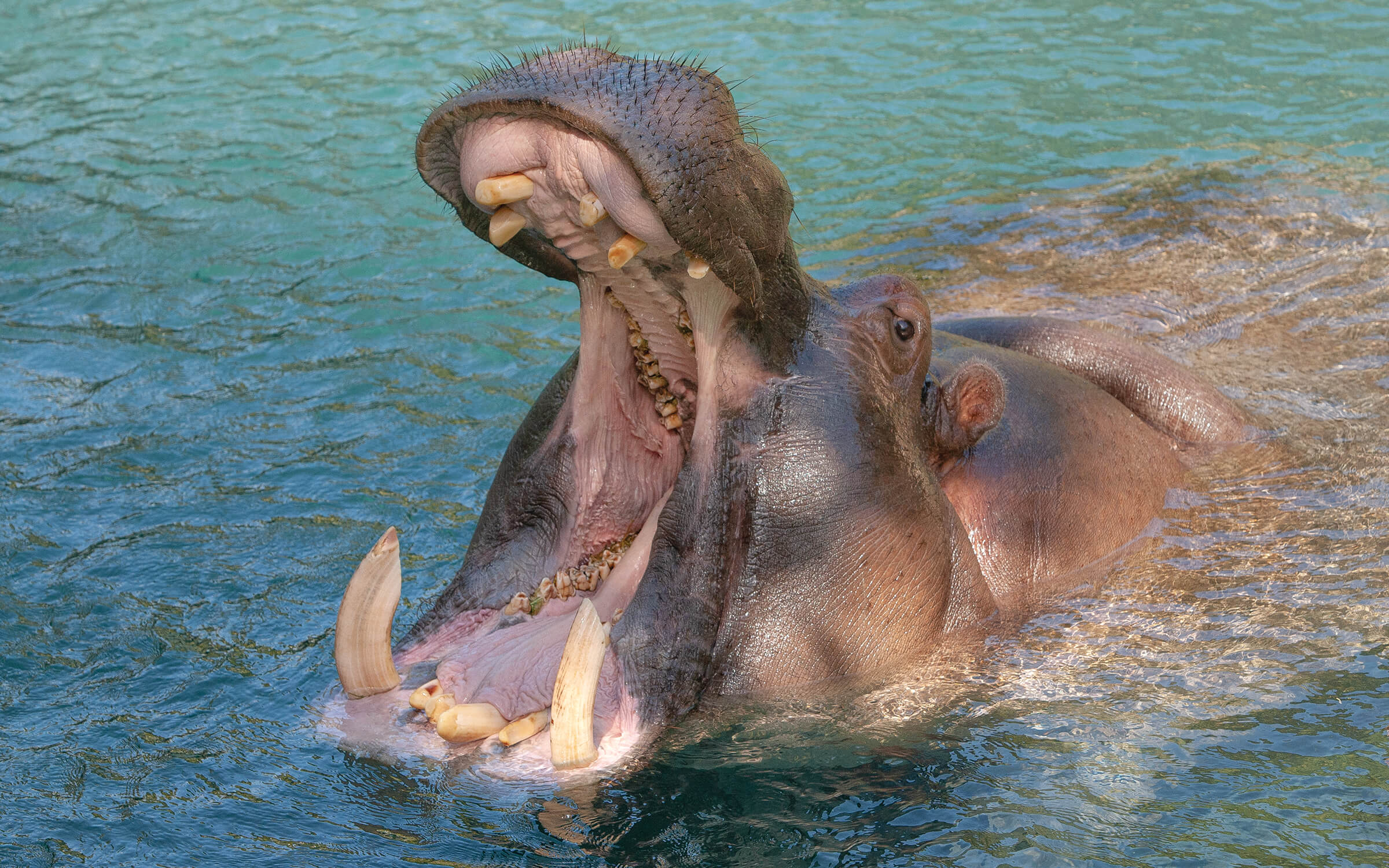
OPEN WIDE
River hippos can open their mouth remarkably wide—at up to a 150-degree angle. Their canine and incisor teeth grow continuously, and the canines can be up to 20 inches long.
Facing challenges
In their native habitats, hippos and cetaceans face threats caused by humans. For whales, threats include human development along coastlines, climate change that is altering their migration and feeding habits, whale hunting, and water pollution. Two cetacean species are currently categorized as Critically Endangered, seven are Endangered, six are Vulnerable, and five are Near Threatened on the International Union for Conservation of Nature (IUCN) Red List of Threatened Species.
Hippos also face threats from habitat loss related to human development and climate change, along with poaching of their tusks for ivory and their meat for the bushmeat trade. “We all think of elephants as targets of ivory poachers, but unfortunately, hippos are also on that list,” Jen pointed out. Because hippo tusks are softer and easier to carve than elephant ivory, they continue to be in high demand. River hippos are categorized as Vulnerable on the IUCN Red List, and pygmy hippos are listed as Endangered.
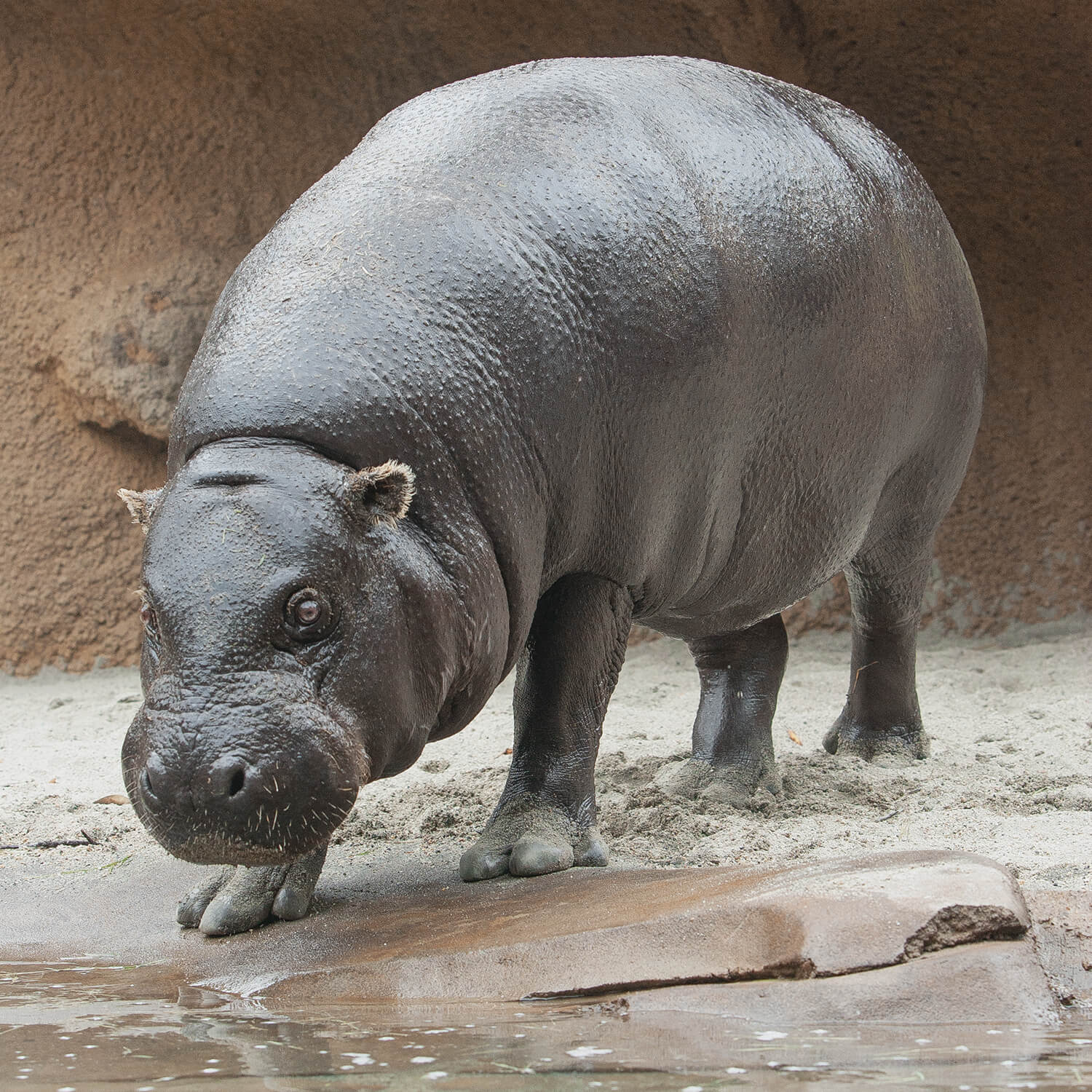
SMALLER, BUT STILL BIG
Pygmy hippos (bottom right) weigh about one tenth as much as river hippos, and are smaller and less aquatic.
San Diego Zoo Hippos
At one end of Hippo Trail in Lost Forest, Zoo guests can see male pygmy hippo Elgon. The (relatively) petite pygmy hippos weigh 350 to 600 pounds—about one tenth the weight of river hippos. They are also less aquatic. Their toes are less webbed, their legs are longer, and instead of two or three pairs of incisor teeth like river hippos, they have just one pair. Pygmy hippos tend to either be solitary or live in small family groups.
At the other end of Hippo Trail, in the river hippo exhibit, guests can see Tony, his mother, Funani, and Tony’s father, Otis. Otis and Funani have had four calves together, and when Funani is not raising a calf, both continue to show interest in each other, Jen said—interestingly, usually when there is a full moon. Tony is now becoming a lot more independent, even though he is still nursing. “He’s venturing away from Funani a lot more,” Jen said. “He’ll be in the stall, and she’ll call him when she’s in the pool. He’ll call back, like he’s saying ‘I’m fine!’ He will continue to assert his independence more as he nears weaning.”
Next time you visit the Zoo’s hippos, take another look. It may seem like a whale of a comparison, but see if you can call out the many characteristics that hippos and their cetacean relatives share.

